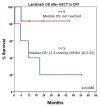Real-World Outcomes in FLT3-ITD Mutated Acute Myeloid Leukemia: Impact of NPM1 Mutations and Allogeneic Transplantation in a Retrospective Unicentric Cohort
- PMID: 40725802
- PMCID: PMC12294857
- DOI: 10.3390/jcm14145110
Real-World Outcomes in FLT3-ITD Mutated Acute Myeloid Leukemia: Impact of NPM1 Mutations and Allogeneic Transplantation in a Retrospective Unicentric Cohort
Abstract
Background/Objectives: Acute myeloid leukemia (AML) with FLT3 internal tandem duplication (FLT3-ITD) mutations carries a poor prognosis. While FLT3 inhibitors like midostaurin show benefits in combination with chemotherapy, the role of allelic ratio (AR), NPM1 mutation status, and hematopoietic stem cell transplantation (HSCT) remains uncertain. Real-world data can help refine prognostic classification and treatment strategies. Methods: We retrospectively analyzed 37 fit patients with FLT3-ITD AML treated with standard "7+3" chemotherapy, with and without midostaurin, between 2013 and 2022. Patients were stratified by FLT3-ITD AR, NPM1 status, and treatment approach. Outcomes assessed included complete remission (CR), disease-free survival (DFS), and overall survival (OS). Results: Overall, 67.6% achieved CR/CRi. Response rates did not differ significantly by AR (low vs. high: 66.7% vs. 69.2%) or midostaurin use (72.6% vs. 60%; p = 0.49). NPM1 mutations were associated with improved DFS (10.3 vs. 3 months, p = 0.036) but not OS. HSCT, performed in 54.1% of patients, mainly in first remission (CR1), significantly prolonged DFS (not reached vs. 5.3 months, p = 0.005) and remained an independent predictor in multivariate analysis (HR: 0.160, p = 0.039). OS (median 15.1 months) did not vary significantly across subgroups. Among patients achieving CR1, OS was significantly longer in those who underwent HSCT after midostaurin-based induction compared to those not transplanted (median OS not reached vs. 12.8 months; 95% CI, 6.9-18.7; p = 0.045), whereas no significant benefit was observed after standard induction. In a landmark analysis restricted to patients transplanted in CR1, those who had received midostaurin-based induction showed a trend toward improved OS compared to those treated with standard induction (median OS not reached vs. 11.5 months; 95% CI, 0.5-25.0; p = 0.086). Conclusions: This real-life study supports the importance of NPM1 mutations and HSCT in CR1, especially in the midostaurin era, for improving DFS in FLT3-ITD AML. These findings support updated guidelines for reducing the prognostic weight of AR and highlight the need for improved post-remission strategies in this setting.
Keywords: ELN guidelines; FLT3-ITD; acute myeloid leukemia; allelic ratio; midostaurin; overall survival.
Conflict of interest statement
CV was on the advisory board for Abbvie, Astellas, Jazz, BMS, and Otsuka. The remaining authors declare no relevant conflicts of interest.
Figures




Similar articles
-
Clinical Characteristics and Outcomes of Acute Myeloid Leukemia Patients Harboring NPM1/FLT3-ITD/DNMT3A Triple Mutations and the Potential Prognostic Value of GNG4.Cancer Control. 2025 Jan-Dec;32:10732748251359836. doi: 10.1177/10732748251359836. Epub 2025 Jul 17. Cancer Control. 2025. PMID: 40676766 Free PMC article.
-
Outcomes of patients with newly diagnosed acute myeloid leukemia with FLT3-tyrosine kinase domain mutations: Prognostic implications of NPM1 co-mutation.Cancer. 2025 Aug 15;131(16):e70032. doi: 10.1002/cncr.70032. Cancer. 2025. PMID: 40782343 Free PMC article.
-
Clinical significance of FLT3-ITD/CEBPA mutations and minimal residual disease in cytogenetically normal acute myeloid leukemia after hematopoietic stem cell transplantation.J Cancer Res Clin Oncol. 2021 Sep;147(9):2659-2670. doi: 10.1007/s00432-021-03530-9. Epub 2021 Feb 7. J Cancer Res Clin Oncol. 2021. PMID: 33550446 Free PMC article.
-
Impact of secondary-type mutations on the prognosis of AML patients with NPM1 mutation: a systematic review and meta-analysis.Ann Hematol. 2025 Jun;104(6):3103-3115. doi: 10.1007/s00277-025-06431-w. Epub 2025 May 28. Ann Hematol. 2025. PMID: 40434717 Free PMC article.
-
Optimisation of chemotherapy and radiotherapy for untreated Hodgkin lymphoma patients with respect to second malignant neoplasms, overall and progression-free survival: individual participant data analysis.Cochrane Database Syst Rev. 2017 Sep 13;9(9):CD008814. doi: 10.1002/14651858.CD008814.pub2. Cochrane Database Syst Rev. 2017. PMID: 28901021 Free PMC article.
Cited by
-
Does the Timing of Response Impact the Outcome of Relapsed/Refractory Acute Myeloid Leukemia Treated with Venetoclax in Combination with Hypomethylating Agents? A Proof of Concept from a Monocentric Observational Study.J Clin Med. 2025 Aug 7;14(15):5586. doi: 10.3390/jcm14155586. J Clin Med. 2025. PMID: 40807220 Free PMC article.
References
-
- Oran B., Cortes J., Beitinjaneh A., Chen H.C., de Lima M., Patel K., Ravandi F., Wang X., Brandt M., Andersson B.S., et al. Allogeneic Transplantation in First Remission Improves Outcomes Irrespective of FLT3-ITD Allelic Ratio in FLT3-ITD–Positive Acute Myelogenous Leukemia. Biol. Blood Marrow Transplant. 2016;22:1218–1226. doi: 10.1016/j.bbmt.2016.03.027. - DOI - PMC - PubMed
-
- de Jonge H.J.M., Valk P.J.M., de Bont E.S.J.M., Schuringa J.J., Ossenkoppele G., Vellenga E., Huls G. Prognostic Impact of White Blood Cell Count in Intermediate Risk Acute Myeloid Leukemia: Relevance of Mutated NPM1 and FLT3-ITD. Haematologica. 2011;96:1310–1317. doi: 10.3324/haematol.2011.040592. - DOI - PMC - PubMed
LinkOut - more resources
Full Text Sources
Research Materials
Miscellaneous

